top of page
Trollope's Victorian world comes alive through images of Trollope and his Family, Friends, Colleagues and Contemporaries, Books and Writings, Places and Conveyances, and Documents, Memorials and Remembrances that collectively define his life and times.
Further information on permissions for images which are attributed
Trollope and His Family
 Probably Anthony or Henry Trollope (by Auguste Hervieu, watercolor,1832). Attributed. |  Probably Thomas Adolphus Trollope (by Auguste Hervieu, watercolor, 1832). Attributed. |
|---|---|
 Frances Trollope (by Auguste Hervieu, oil on canvas, circa 1832). Attributed. |  Trollope (by Samuel Laurence, oil on canvas, circa 1864). Attributed. |
 Anthony Trollope (by Ashford & Co, albumen CDV, circa 1860s). Attributed. |  Rose Trollope, nee Heseltine, Trollope's wife. |
 Anthony Trollope (by Adolphe Naudin, albumen CDV, 1865). Attributed. |  Trollope, circa 1870s. |
 Cecilia Tilley, nee Trollope (by Auguste Hervieu, oil on canvas, circa 1838). |  Anthony Trollope (by Elliott and Fry, albumen CDV, circa 1864). Attributed. |
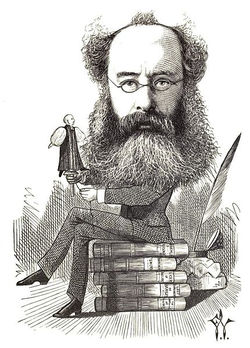 Anthony Trollope, Once a Week magazine caricature, 1872. |  Frances Trollope (by William Holl Jr, after Lucy Adams, after Auguste Hervieu, stipple engraving, published 1845 (circa 1832)). Attributed. |
 Sir John Tilley, Trollope's close friend and brother-in-law, Secretary of the Post Office (1864-1880). |  Anthony Trollope (by Henry Furniss, pen and ink, circa late 19th century). Published in Some Victorian Men, 1927. Attributed. |
 Anthony Trollope caricature "St. Anthony" in Melbourne Punch, April 17, 1873. |  Thomas (Tom) Adolphus Trollope, brother, circa early 1880s. |
 Frank Anthony Trollope (by Charles Collins, photograph, 1878), Trollope's grandson. Attributed. |  Sir John Anthony Cecil Tilley (by Walter Stoneman, bromide print, 1919), British ambassador to Japan and Brazil, son of Sir John Tilley and Trollope's godson. Attributed. |
 Sir John Trollope,1st Baron Kesteven (by Joseph Brown, published by Bailey & Co., after a photograph by Southwell Bros., stipple engraving, 2 January 1865), Trollope's second cousin and hunting partner. Attributed. |  Trollope, circa 1860. |
 Trollope, circa 1870s. |  Thomas (Tom) and Anthony Trollope, circa early 1860s. |
 Theodosia Trollope, nee Garrow, author and first wife of Trollope's brother Tom. |  Trollope (by R. Birch, sketch after Sarony, 1883), published in The Century Illustrated NY. |
 Harry Reginald Trollope (by Charles Collins, photograph, 1878), Trollope's grandson. Attributed. | 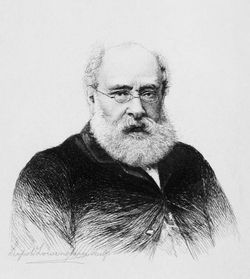 Trollope, circa 1878. |
 Frederick Farrand Trollope (by Charles Collins, photograph, 1878), Trollope's grandson. Attributed. |  Trollope on white Icelandic pony during the "Mastiffs" trip to Iceland, 1878. |
 Trollope's Garrick Club portrait (by Henry Nelson O'Neil, oil on canvas, circa 1860s). Attributed. |  Trollope (by Marcus Ward, albumen CDV, circa 1860). |
 Excerpt of Trollope from 'A Private View at the Royal Academy' (William Powell Frith, oil on canvas, 1881). Attributed. |  Anthony Trollope (by Sir Leslie Ward, chromolithograph, 1873). Attributed. |
 Frances Eleanor Trollope, nee Ternan, author and second wife of Trollope's brother Tom. |  Trollope and Rose aboard "The Mastiff" en route to Iceland (by Jemima Blackburn, ink sketch, 1878). |
 Beatrice 'Bice' Trollope (Mrs. Charles Stuart Wortley)(by Edith Corbet, oil on canvas, circa 1870s), Trollope's niece. Attributed. | 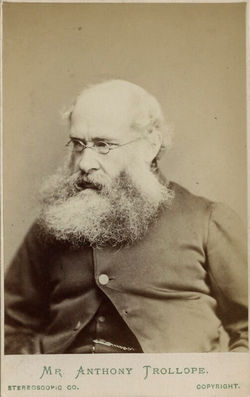 Trollope (by London Stereoscopic and Photographic, albumen CDV, circa 1870s). Attributed. |
 Anthony Trollope caricature in The Lantern, Cape Town, South Africa, 1878. |
Trollope and Family
Friends, Colleagues and Contemporaries
 Burton chalk of George Eliot, author and close friend of Trollope, 1865 (attributed) | 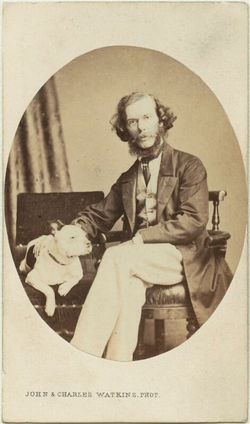 Watkins albumen photo of George H Lewes, critic and philosopher and close friend of Trollope, 1864 (attributed) |
|---|---|
 Vinter oil of Sir Rowland Hill, Secretary of the Post Office, 1854-1864, during peak of Trollope's career (from Maull and Polyblank print of 1857) (attributed) |  Sir Francis Freeling, Secretary of the Post Office, 1797-1836, Trollope's first employer (attributed). |
 Frederic Chapman, head of Chapman and Hall and close friend of Trollope, circa late 1880s |  Hughes and Edwards print of Victorian writers,1876 (attributed) |
 Collier oil of Geoge Smith, head of Smith, Elder and Cornhill Magazine and close friend of Trollope, 1901 (attributed) |  Watts oil of Sir John Everett Millais, painter and illustrator and close friend of Trollope, circa 1871. |
 Millet oil of Kate Field, American author and close friend of Trollope, circa 1881 |
Trollope's Friends, Colleagues, and Contemporaries
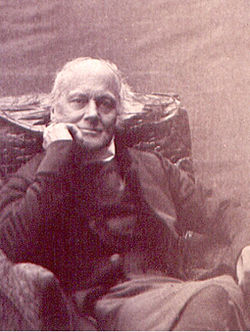 Reverend Charles Longley, Archbishop of York and Canterbury, Headmaster of Harrow School during Trollope's last two years at school (1831-3). |  Reverend Henry (Harry) Joseph Thomas Drury (by Thomas Hodgetts, after Margaret Sarah Carpenter mezzotint, attributed, 1828), friend of Thomas and Fanny Trollope, Master at Harrow School and Trollope's tutor. |
|---|---|
 Reverend William Drury (attributed, 1860), a one-time Harrow schoolmaster who employed Trollope as a classical instructor in his Brussels academy in 1834. |  William Makepeace Thackeray (by Holl, steel engraving after Lawrence painting, circa 1853), author, editor, club partner and close friend of Trollope. Attributed. |
 Major General James Grant (by William Salter, oil on canvas, 1834-1840), British army officer serving in India, Sicily, Waterloo. Grant and his wife Penelope were neighbors of the Trollope family in Harrow in the early 1830s and helped care for them prior to their flight to Bruges. Attributed. |  William Wilkie Collins, author and friend of Trollope, 1903. |
 Elizabeth Barrett Browning (by Barlow, engraving of Havre photo, 1858), poet and friend of Trollope. |  Robert Browning, poet and playwright and friend of Trollope, 1865. |
 Charles Dickens, author and friend of Trollope, circa early 1860s. |  Nathaniel Hawthorne (by Charles Osgood, oil on canvas, 1840), author and friend of Trollope. |
 Charles James Lever (by Octavius, Charles Watkins albumen CDV, late 1860s/early 1870s), author and friend of Trollope. Attributed. |  George Housman Thomas, artist, engraver and illustrator, completed the illustrations for The Last Chronicle of Barset. |
 Marcus Stone, RA, painter and illustrator, completed the illustrations for He Knew He Was Right. Attributed. |  Sir Leslie Stephen, author, essayist, editor of Cornhill Magazine and Directory of National Biography, friend of Trollope and contributor to Saint Paul's Magazine, circa 1860; Stephen was the father of novelist Virginia Woolf. |
 Frederick Locker-Lampson, civil servant, poet, Trollope's friend and club mate at the Cosmopolitan and Athenaeum; he contributed poetry to Saint Paul's Magazine. |  George Goschen, 1st Viscount Goschen, businessman, director of the Bank of England and friend of Trollope; he contributed several articles to Saint Paul's Magazine. |
 William Small, painter and illustrator, completed the illustrations for Marion Fay, circa 1882. |  Robert Bell (by Clarkington & Co - Charles Clarkington, albumen CDV, 1860), author and close friend of Trollope. Attributed. |
 William Wilkins Glenn, American journalist and newspaper owner and friend of Trollope; he hosted Trollope in Baltimore and was a periodic visitor at Waltham. |  Sir Evelyn Wood, Adjutant General serving in Crimea and India, hunting partner and friend of Trollope. |
 Anna Caroline Steele, author and playwright, close friend and hunting partner of Trollope's, circa 1900. |  Henry Danby Seymour, politician, writer, early partner of the Fortnightly Review and friend of Trollope. |
 John Robert Godley, Irish writer and statesman, founder of Canterbury in New Zealand, and schoolmate of Trollope's at Harrow; Trollope dedicated a chapter to Godley in Australia and New Zealand. |  Philip Stanhope, 5th Earl Stanhope (by Thomas Richard Williams, albumen CDV, 1864, given by Algernon Graves, 1916), politician, president of the Royal Literary Fund, sponsor of the creation of the National Portrait Gallery, and Trollope's friend and club mate at the Athenaeum. Attributed. |
 Gustavus Cornwall, Secretary of the Dublin GPO during Trollope's tenure, hosted Trollope during his last Irish trips, circa 1884. |  William Edward Forster, industrialist and politician, member of the Athenaeum and Cosmopolitan Clubs, friend of Trollope and one of his regular whist partners. Attributed. |
 Francis (Frank) Montague Holl, RA (by Lock & Whitfield, published by Sampson Low, Marston, Searle and Rivington, woodbury type, published 1883), painter and illustrator who completed the illustrations for Phineas Redux. Attributed. | 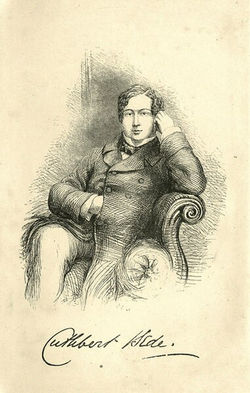 Reverend Edward Bradley, cleric, illustrator and writer (penname Cuthbert Bede), friend of Trollope who periodically assisted with editing at Saint Paul's Magazine. |
 William Monsell, 1st Baron Emly, landowner, statesman and Post Master General; he was a schoolmate of Trollope's at Winchester and hosted him during his Irish travels, circa 1860. |  Edward Dicey, journalist, writer, and editor, acted as sub-editor under Trollope at Saint Paul's Magazine, circa 1865. |
 Matthew Higgins, writer for Cornhill Magazine, Pall Mall Gazette and other periodicals (under the penname Jacob Omnium), and close friend of Trollope. |  Henry Austin Dobson, poet and essayist and friend of Trollope, circa 1906. |
 Thomas William Anson, 1st Earl of Lichfield (when Viscount Anson, by and published by Charles Turner, after Thomas Phillips mezzotint, published 24 April 1823 (1819)), politician, Master of Buckhounds and Postmaster General during Trollope's first years at the GPO; he reprimanded Trollope for his performance and ultimately approved his transfer to Ireland. Attributed. |  Sir George Jessel (by Lock and Whitfield, woodbury type, 1881 or before), barrister, politician, jurist, Trollope's colleague at the Royal Literary Fund and regular whist partner at the Athenaeum. Attributed. |
 General Sir Henry Brackenbury, military officer, contributor to Saint Paul's Magazine, and friend of Trollope, circa 1904. |  Sir Henry James, 1st Baron James of Hereford, lawyer, Solicitor General, Attorney General and close friend of Trollope, circa 1882. |
 Eneas Sweetland (ES) Dallas, journalist, critic and editor, Garrick club colleague of Trollope's and supporter of his early work. |  Henry Woods, painter and illustrator, completed the illustrations for The Vicar of Bullhampton. |
 Sir Riichard Quain, Harley Street physician, editor of the Dictionary of Medicine, Physician Extraordinary for Queen Victoria, and Trollope's own physician in his final years, circa 1881. |  Matthew Arnold, civil servant, writer and poet, and friend of Trollope, circa 1883. |
 James Edward Sewell, academic, warden of New College, Oxford, and friend and hunting partner of Trollope, circa 1885. |  Sir William Howard Russell, journalist and war correspondent and close friend of Trollope, circa 1905. |
 Alfred Austin, author and poet laureate and close friend of Trollope, circa 1900. |  John Morley, 1st Viscount Morley of Blackburn (by W. & D. Downey, published by Cassell & Company, carbon print, published 1890). Morley, an MP, was editor of The Fortnightly Review (1865-1882) and Pall Mall Gazette (1880-1883), working closely with Trollope. Attributed. |
 Mary Ellen Edwards, painter and illustrator, completed the illustrations for The Claverings. |  Henry O'Neil, RA, artist and writer and close friend of Trollope; O'Neil painted Trollope's portrait for The Garrick. Circa 1860's. Attributed. |
 Richard Henry Dana, American lawyer and politician, and friend of Trollope, circa 1868. |  Walter Herries Pollock, author and editor of The Saturday Review and close friend of Trollope, circa 1895. |
 Gustavus Hare, Commissioner of Police in Albany, Australia, Trollope's schoolmate at Winchester, and host during his Australian trips. |  Sir Charles Trevelyan, 1st Baronet, Civil Service reformer and Colonial administrator; Trollope caricatured him in The Three Clerks -- the two would later become close friends. |
 Charles Allston Collins, painter and writer, brother of author Wilkie Collins and friend of Trollope. | 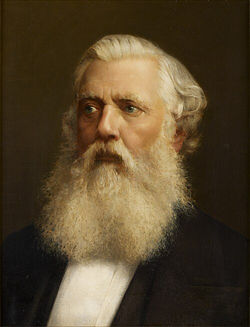 Sir Austen Henry Layard, archaeologist, politician and writer, and close friend of Trollope, circa 1890. |
 Anne Thackeray Ritchie, author and eldest daughter of William Makepeace Thackeray, and friend of Trollope, circa 1870. |  Henry Stuart Russell, politician, explorer and historian, who emigrated to Australia in 1840. He was a classmate of Trollope's at Harrow (1831-33) and became acquainted with Fred Trollope in Australia. |
 Mary Penniman (nee Knower), widow of American oil merchant Sam Penniman, and friend of Trollope, circa 1883. |  Edward Chapman, co-founder of Chapman and Hall, Trollope's publisher. He retired from the firm in 1866, giving control to his nephew, Frederic. |
 William Longman, head of Longman and Sons, publisher of Trollope's "breakthrough" novels The Warden and Barchester Towers. He rejected The New Zealander, The Three Clerks and The Struggles of Brown, Jones and Robinson. | 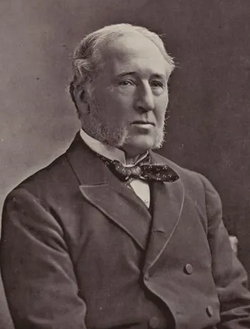 Frederick Greenwood, editor and publisher's reader; Greenwood was editor of Cornhill Magazine and Pall Mall Gazette during the time Trollope made his contributions. |
 George Hamilton, Commissioner of Police, Adelaide, schoolmate of Trollope's at Harrow and host during his Australian trips. |  Sir William Henry Gregory (by Frederick Hollyer, photogravure, 1870's), MP for Galway and Dublin and Governor of Ceylon, schoolmate and later close friend of Trollope. Attributed. |
 William Webb Follett Synge (by Camille Silvy, albumen print, February 1862), diplomat, author and close friend of Trollope; the two first met in Costa Rica in 1859 during Trollope's West Indies trip. Attributed. |  EA Freeman, historian, author and close friend of Trollope; before Trollope's death he told Freeman "Barset was Somerset, but Barchester was Winchester, not Wells"; circa 1892. |
 Richard Monckton Milnes, 1st Baron Houghton, writer, poet and politician, friend of Trollope who sponsored his membership at the Cosmopolitan Club. |  John Burns, 1st Baron Inverclyde, partner and later Chairman of Cunard Shipping, friend of Trollope and host of the "Mastiffs" trip to Iceland, 1901. |
 Colonel William Maberly, Trollope's superior when he joined the GPO in 1834; appointed Secretary of the GPO (1836-1854). |  John Rushout, 2nd Baron Lord Northwick, peer and politician, and Thomas Trollope's landlord (Illots/Julians), circa 1794. |
 Sir William Frederick Pollock, barrister and author and close friend of Trollope; neighbors at Montagu Square. |  Charles Dickens Jr., publisher of All the Year Round, which serialized several of Trollope's later works, 1874. |
 Charles Bianconi, Italian/Irish businessman, Mayor of Clonmel, and developer of the transport coach used for mail delivery, and friend of Trollope. |  John Murray II (by Edward Francis Finden, stipple engraving, 1837), head of the J.Murray publishing house; Murray published Fanny Trollope's Belgian/German travel book and Thomas Trollope's Encyclopedia Ecclesiastica; he requested, but failed to read, Trollope's first efforts at an Irish guidebook. Attributed. |
 Charles Buxton, MP of East Surrey, brewer, philanthropist and close friend of Trollope; he introduced Trollope to the Essex hunts following the move to Waltham. |  Charles William Shirley Brooks (by Elliott and Fry, albumen CDV, 1860s), author and editor of Punch and friend of Trollope. Attributed. |
 Margaret Oliphant, Scottish novelist and historian and friend of Trollope; Trollope featured her work in St. Paul's Magazine, circa 1890s. |  Fletcher Harper, co-founder of Harper and Brothers, Trollope's primary American publisher. Attributed. |
 George Smalley, journalist and head of London branch of the New York Tribune, and friend of Trollope, 1895. |  Sir Charles Taylor, 2nd Baronet Hollycombe, member of the Garrick Club and close friend of Trollope. |
 Charles Mudie, founder of Mudie's subscription and circulating Library, circa 1870s. Trollope's books were very popular at Mudie's. |  William Powell Frith, RA, painter and friend of Trollope; Frith depicted Trollope in 1881's Private View of the Royal Academy. |
 James T. Fields, publisher and editor of Boston-based The Atlantic, and friend of Trollope, circa early 1880s. |  William Henry Smith (WH Smith) (by Elliot and Fry, albumen CDV, 1877-1880), head of WH Smith booksellers and circulating library. Trollope's books were regularly available in the Smith library and at their shops. Attributed. |
 George Rusden, author and historian who lived much of his life in Australia, close friend of Trollope, 1885. |  Charles Gordon, Marquess of Huntley, hunting partner and friend of Trollope, 1882. |
 Elizabeth Gaskell (by George Richmond, chalk, 1851), author and admirer of Trollope's work; the two corresponded but missed meeting in person before her sudden death. Attributed. |  Lord Edward John Stanley, 2nd Baron of Alderley, Postmaster General (1860-66) during Trollope's last years at the GPO, circa 1865. |
 Alexander Macmillan, head of Macmillan Publishers and close friend of Trollope, circa 1891. |  Amelia B. Edwards, author, journalist and Egyptologist, and friend of Trollope, circa 1890. |
 Christian Bernhard von Tauchnitz, founder of Bernhard Tauchnitz publishers, Leipzig, Trollope's primary European publisher. | 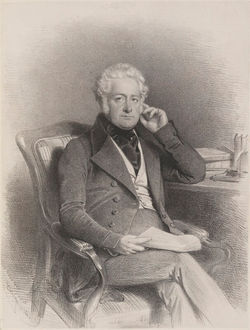 Richard Bentley (by Charles Baugniet, lithograph,1884), Trollope's and Fanny Trollope's publisher. Attributed. |
 William Blackwood III, head of publisher Blackwood & Sons after 1879 and friend of Trollope. |  George Eliot (Mary Ann Evans) (by Sir Frederic William Burton, chalk sketch, 1865), author and close friend of Trollope. Attributed. |
 Thomas Hay Sweet (THS) Escott, author and editor of The Fortnightly Review, friend of Trollope and his first biographer, circa 1914. |  John Blackwood, head of publisher Blackwood & Sons and close friend of Trollope, circa 1878. |
 George Henry Lewes (John and Charles Watkins albumen CDV, 1864, attributed), writer, critic and close friend of Trollope. |  Frederic Chapman, head of publisher Chapman and Hall (succeeding his uncle Edward in 1866) and close friend of Trollope. |
 Sir Rowland Hill (John Alfred Vinter, after Maull & Polyblank oil on canvas, circa 1879, based on a work published in April 1857, attributed), Secretary of the Post Office (1854-1864) during Trollope's tenure. |  Sir Francis Freeling (oil by George Jones, circa 1830, attributed), Secretary of the Post Office (1798-1836), at the time of Trollope's joining. |
 George Smith (John Collier, oil on canvas, 1901, attributed), head of publisher Smith, Elder and Cornhill Magazine and close friend of Trollope. |  Kate Field (Francois Millet oil on canvas, 1887), American writer and close friend of Trollope. |
 "Authors & Novelists" (published by Hughes & Edmonds, albumen print, 1876, attributed), featuring Trollope and his contemporaries. |  "A Memorable Night of Whist at the Athenaeum (Anthony Trollope, Right Hon. WE Forster, Abraham Haywood, Sir George Jessel)." |
 Sir John Everett Millais, 1st Baronet, RA (George Frederic Watts, oil on canvas,1871, attributed), painter, illustrator and close friend of Trollope. He completed illustrations for Framley Parsonage, Phineas Finn, Orley Farm and The Small House at Allington. |
Friends
Writings
Trollope's Books and Writings
 The Pall Mall Gazette, a London evening newspaper founded by publisher George Smith. Trollope contributed more than 70 articles to the newspaper between 1865 and 1880. |  The Illustrated London News, a weekly periodical that frequently reviewed Trollope's novels. |
|---|---|
 The Bertrams, Ward, Lock yellowback, circa 1881. | 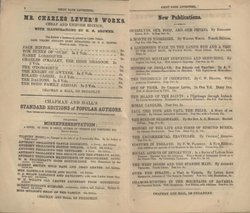 Advertisements in Orley Farm parts issue, Volume 8, 1861. |
 The Claverings, early edition. |  Framley Parsonage, title page, German translation, 1864. |
 Cousin Henry, volume from Royal Select Library, 1879. |  Blackwoods Magazine's serial installment of Nina Balatka, 1866. |
 Ayala's Angel, French translation, modern. |  Lippincott's Magazine (Philadelphia), serial installment of Harry Hotspur, 1870. |
 The Golden Lion of Granpere, first American edition with Fraser illustrations, 1872. |  Phineas Finn, title page, first edition, 1869. |
 The Vicar of Bullhampton, title page with Woods illustration, 1870. |  Barchester Towers, Chinese translation, modern. |
 Millais illustration from Framley Parsonage, 1861. |  Chapman and Hall advertisement in the Fortnightly Review, 1865, listing available works by Trollope (as well as Dickens and Carlyle). |
 The Warden, Finnish translation, modern. |  Dr. Wortle's School, Ward, Lock yellowback, 1881. |
 The Australasian, serial installment of Lady Anna, 1873. |  Autobiography, George Munro (US) Seaside Library edition, 1888. |
 Chapman and Hall advertisement for yellowback editions of Trollope (and his friend Lever's) books. |  Fraser illustration from Ralph the Heir, 1871. |
 Can You Forgive Her? title page, first American edition, Harper and Brothers, 1865. |  Littell's Living Age (Boston), serial installment of Phineas Finn, 1867. |
 The Examiner, a weekly periodical that frequently reviewed Trollope's novels. |  Barchester Towers, Japanese translation, modern. |
 Ralph the Heir, Chapman and Hall yellowback, 1876. |  Barchester Towers, Spanish translation, modern. |
 The Fortnightly Review, serial installment of The Belton Estate, 1865. |  The Vicar of Bullhampton, parts issue, 1869-1870 (attributed). |
 Barchester Towers, Russian translation, modern. |  The London Review, a weekly periodical that frequently reviewed Trollope's novels. |
 He Knew He Was Right, Chapman and Hall Select Series yellowback, circa 1871 |  The Graphic serialization of Phineas Redux 1873-4. |
 Cornhill Magazine serialization of The Struggles of Brown, Jones and Robinson, 1861-2. |  The Prime Minister, Belford Bros., 1876. |
 The Belton Estate, French translation, early edition. | 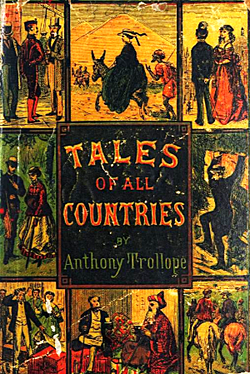 Tales of All Countries, 1st series, Chapman and Hall Select Series yellowback, 1867. |
 Stone illustration from He Knew He Was Right, 1869. |  The Small House at Allington, Smith, Elder edition, 1864. |
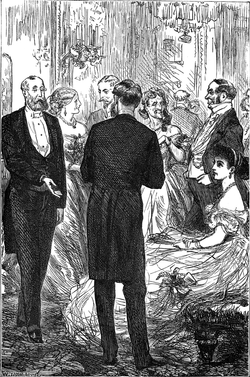 Thomas illustration from The Last Chronicle of Barset, 1867. |  Orley Farm, parts issue, 1862. Attributed. |
 Australia and New Zealand, Chapman and Hall edition, 1876. |  The Galaxy (NY), serial installment of The Claverings, 1866. |
 Thomas illustration from The Last Chronicle of Barset, 1867. |  Christmas at Thompson Hall short story, Knight/Cosy Corner edition, 1893. |
 Review and David Friston sketch for Shilly-Shally, an adaptation of Trollope's Ralph the Heir which he did not authorize. The play ran for 1 month at the Gaiety Theater in 1872. |  The Spectator, a weekly periodical that frequently reviewed Trollope's novels. |
 Sir Harry Hotspur, Ward, Lock edition, 1883. |  The Duke's Children, original manuscript page. Attributed. |
 The Duke's Children, expanded edition, which restores 65,000 words Trollope removed from his original manuscript, 2015. |  Ralph the Heir, Chapman and Hall Select Series yellowback, 1872. |
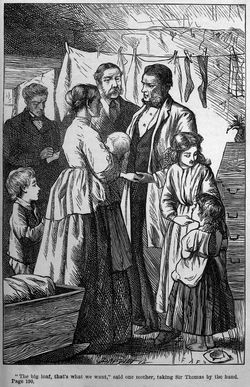 Fraser illustration from Ralph the Heir, 1870. |  Thomas illustration from The Last Chronicle of Barset, 1867. |
 Mudie's Select Library book label. |  Trollope's handwritten notes in his copy of Shakespeare's Edward III. Attributed. |
 Browne illustration from Can You Forgiver Her?, 1864. | 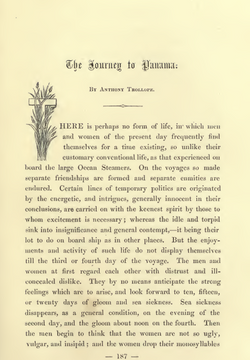 Victoria Regia compendium featuring The Journey to Panama,1861. |
 Castle Richmond, title page, German translation, 1863. |  Thomas illustration from The Last Chronicle of Barset, 1867. |
 The Bertrams, title page, Tauchnitz edition, 1859. |  Fawkes illustration from The Way We Live Now, 1875. |
 Hunting Sketches, early edition. |  Saint Paul's Magazine, excerpt of Trollope's introductory editorial preface, 1867. |
 The Noble Jilt, title page, unpublished play by Trollope forming the basis of his novel Can You Forgive Her?, published 1923. |  Frau Frohmann short story collection, Isbister, 1882. |
 Every Saturday (Boston) serial installment of He Knew He Was Right, 1869. |  Edwards illustration from The Claverings, 1867. |
 Trollope's handwritten notes in Marlowe's The Jew of Malta. Attributed. |  Phineas Redux, Chapman and Hall, 1874. |
 Cornhill Magazine, final serial installment of The Claverings, 1867. |  Millais illustration from Orley Farm, 1862. |
 Saint Paul's Magazine, where Trollope served as editor from late 1866-1870. |
Places and Conveyances
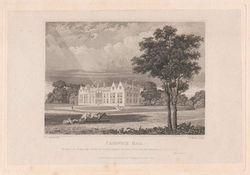 Casewick Hall, Lincolnshire, historic Trollope family seat. |  Casewick Hall, Lincolnshire, historic Trollope family seat (modern view). |
|---|---|
 No.3 High Street, Rotherham, head office of Sheffield and Rotherham Bank and home of the Hesletine family from 1828-1853; Edward Heseltine, Rose's father, as bank manager, was entitled to live with his family on the top floor. | 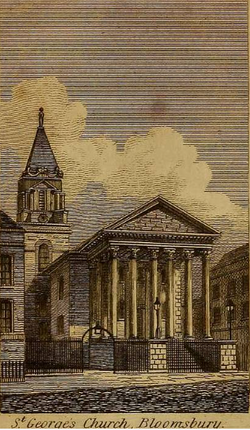 St. George's Church, Bloomsbury, site of Trollope's 1815 baptism, circa 1826. |
 Old Square, Lincoln's Inn, site of Thomas Anthony Trollope's law offices (No. 23 Old Square) until 1828, circa 1876. Attributed. |  The Athenaeum Club, which Trollope joined in 1864. |
 Harrow Weald, Trollope family home from 1831-1834. Attributed. |  The Old Bailey (Central Criminal Court), featured in Orley Farm, The Three Clerks and Phineas Redux. |
 The Garrick Club, which Trollope joined in 1862. |  Saint Paul's Cathedral, referenced in The Warden and the namesake of the monthly magazine launched by Trollope and Virtue in 1867, circa 1865-1885. Attributed. |
 Saint George's Church, Hanover Square, Mayfair, referenced in Marion Fay and Ayala's Angel (modern view). | 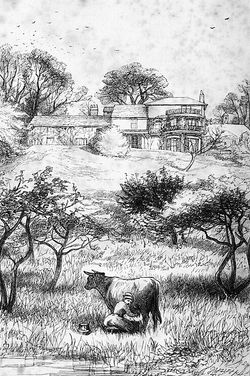 Millais illustration of Julian Hill (now Julian Way), used as frontispiece of Orley Farm. Trollope family home from 1819-1830. |
 SS Idaho, which Trollope and Rose sailed on from Honolulu to San Francisco in 1873. He wrote part of Australia and New Zealand while on board. |  Saint Dunstan's Church, Fleet Street, referenced in The Warden, circa 1842. |
 Julians (now Julian Hill House), Harrow, Trollope family home from 1816-1819. |  Covent Garden produce market, featured in The London Tradesmen and referenced in The Way We Live Now and The Three Clerks. |
 Billingsgate Fish Market docks and central building, featured in The London Tradesmen. |  Julian Hill (now Julian Way), Trollope family home 1819-1830. |
 "The Smoking Room at the Garrick Club on King Street, 18th October 1859" (by Sir John Gilbert, pen and ink drawing); Trollope joined the club in 1862. Attributed. |  Smithfield Market, featured in The London Tradesmen. |
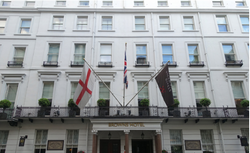 Brown's Hotel, Mayfair, referenced in Lady Anna and The Landleaguers (modern view). |  Rushden House (Julians), Hertfordshire, home of Adolphus Meetkerke, Thomas Anthony Trollope's uncle; Thomas failed to inherit the estate. Attributed. |
 Winchester College, where Trollope was a student from 1827-1830, circa 1865. |  North End, Harting, Trollope's home from 1880-1882. |
 RMS Africa, which Trollope sailed on from NY to Liverpool in 1859. He wrote part of The West Indies and the Spanish Main while on board. Attributed. |  Felsenegg, Switzerland, circa 1872, a favorite vacation locale of Trollope and Rose in the 1870s. Trollope wrote much of Ayala's Angel during an 1878 visit. |
 St. Mary's Church, Hadley, site of Emily Trollope's grave. Trollope sets scenes in and around the church and recalls his sister's funeral in The Bertrams. |  Adelphi Terrace, offices of the Royal Literary Fund, where Trollope served as an active member from 1864 to 1882; he was Treasurer for 13 years and gave 7 RLF dinner addresses. |
 SS Nebraska, which Trollope and Rose sailed on from NZ to Honolulu in 1873. He wrote part of Australia and New Zealand while on board. Attributed. |  Cliffs of Moher, Galway, setting for certain dramatic scenes in An Eye for An Eye. |
 HMS Vixen, which Trollope sailed on from Panama to Costa Rica in 1859. |  Shepheard's Hotel, Cairo. Trollope stayed at the hotel during his 1858 trip and later referenced it in The Bertrams. |
 Culzean Castle, South Ayrshire, Scotland, Trollope's apparent inspiration for Portray Castle in The Eustace Diamonds (modern view). |  North End, Harting, Trollope's home from 1880-1882 (later view). |
 Bishopsgate Station, Shoreditch, circa 1865. Trollope used this station for his regular commutes between Waltham Cross and London between 1860-1872. |  "The Mastiff," ship owned by John Burns, used for the sailing party with Trollope to Iceland (and documented in How the "Mastiffs" Went to Iceland), circa 1906. |
 SS Caldera, which Trollope sailed on from Dartmouth to Cape Town in 1877. He wrote the last part of John Caldigate while on board. |  Coole Park, Galway, home of Sir William and Lady Gregory; Trollope was a periodic guest during his early years in Ireland. The house fell into disrepair in 1932 and was demolished in 1941. |
 Downtown Mallow, the town home to the Trollope family, 1848-1851, circa 1880. |  Silver Springs, Clonmel, home of Charles and Eliza Bianconi; Trollope was a regular guest, and Eliza believed that Silverbridge in The Last Chronicle of Barset was intended to recall the house. |
 Culzean Castle, South Ayrshire, Scotland, Trollope's apparent inspiration for Portray Castle in The Eustace Diamonds, circa 1829. |  Old Rectory, Lowick, home of Reverend William Lucas Collins, a friend of Trollope; Trollope wrote Dr. Wortle's School during a 3 week stay at the home (modern view). |
 The Athenaeum Club, Drawing Room (by James Holland, oil on canvas, 1841); Trollope joined the club in 1864. |  SS Great Britain, which Trollope sailed on from Liverpool to Melbourne in 1871. He wrote Lady Anna in its entirety while on board. |
 Fryston Hall, West Yorkshire, home of Trollope's friend Richard Monckton Milnes, 1st Baron Houghton. Trollope and Rose were regular guests. | 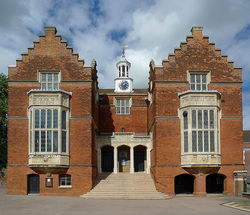 Harrow School, where Trollope was a student from 1823-1825 and 1831-1833 (modern view). Attributed. |
 The Garrick Club, Dining Room; Trollope joined the club in 1862. |  General Post Office at St-Martin's-le-Grand, 1820-1910, location of Trollope's first postal job. |
 Hadley Green, Barnet, home of Fanny Trollope 1836-1838; Trollope visited regularly (modern view). Attributed. |  Harrow School, where Trollope was a student from 1823-1825 and 1831-1833, circa 1892. |
 RMS Atrato, which Trollope sailed on from Southampton to St. Thomas in 1858. He wrote a portion of The Bertrams while on board. |  Smith, Elder offices, Trollope's publisher. |
 St. George's Church, Bloomsbury, site of Trollope's 1815 baptism (modern view). |  Montacute House, Somerset, Trollope's inspiration for Ullathorne in Barchester Towers (modern view). Attributed. |
 Harting, Sussex, village home to Trollope's last house, 1880-1882. |  RMS Trent, which Trollope sailed on between Nicaragua and Panama in 1859. In 1861 the Trent was intercepted by the USS Jacinto and two Confederate envoys were apprehended, causing a political furor. |
 All Saints Church (Rotherham Minster), Rotherham, site of Trollope's marriage in 1844 (modern view). Attributed. |  Beverley Arms Hotel, Beverley, Trollope's inspiration for The Percy Standard in Ralph the Heir (modern view). |
 Hospital of St Cross, Winchester, referenced in Trollope's The Warden (modern view). Attributed. |  St. Mary's Church, Harting, where Trollope attended services 1880-1882 (modern view). |
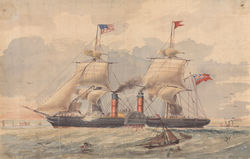 RMS Arabia, which Trollope sailed on from Liverpool to Boston in 1861. Attributed. |  Belfast Customs House, site of Trollope's offices as Acting Postal Surveyor for North Ireland in 1853 (modern view). |
 Mudie's Select Library and Hall, 30-34 Oxford Street, where Trollope was one of the leading circulating authors. |  P&O ship Peshawar (Peshawur (1)) which Trollope sailed on from Suez to Ceylon, en route to Melbourne, 1875 (circa 1890). He wrote a portion of Is He Popenjoy? while on board. |
 Bianconi coach (Bian) used in Ireland for transporting people and mail; Trollope worked with Bianconi to expand delivery via Bian during his Irish tenure. |  RMS Bothnia, which Trollope sailed on from New York to Liverpool in 1875. He wrote a small portion of his Autobiography while on board. |
 Waltham House, Waltham Cross, Hertfordshire, Trollope home from 1860-1873. Demolished in 1936. |  Shannon Hotel, Banagher, location of Trollope's rooms from 1841-1844 (modern view). |
 St Mary's Church, Clonmel, site of baptism of Trollope's two sons (modern view). |  Seaview Terrace, Donnybrook, Dublin, Trollope's home from 1855-1859 (later view). |
 Salisbury Cathedral, inspiration for the setting of The Warden and other Barsetshire novels (modern view). |  Villino Trollope, Florence. Home of Tom and Fanny Trollope starting in 1850. Trollope was a regular visitor. |
 Trollope's Bazaar, Cincinnati - purpose built by Fanny Trollope in 1828, sold in 1830, demolished in 1881. Attributed. |  Greylands, Minchinhampton, home of Rose, Henry and Ada Trollope starting in 1908 (modern view). |
 39 Montagu Square, Trollope's home from 1873-1880 (modern view). |  Fictionalized map of Barsetshire. Attributed. |
 The Reform Club, referenced in Phineas Finn/Redux. |  The Garrick Club, which Trollope joined in 1862 (modern view). |
Places
Documents, Memorials and Remberances
 Plaque of baptism, St. George's, Bloomsbury. |  Plaque of first Trollope family home in London, 1810. |
|---|---|
 Blue plaque, Belfast Customs House. |  Trollope plaque with coat of arms, Harrow School. Attributed. |
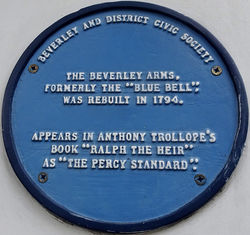 Blue plaque, The Beverley Arms, Beverley, commemorating setting for Trollope's novel Ralph the Heir. Attributed. |  Honorary pillar box plaque - 1 of 5 in London (Fleet Street, Pall Mall, Piccadilly, Rutland Gate, The Strand). |
 Trollope plaque, Poets Corner, Westminster. |  Tombstone of Fanny Trollope (d. 1863), English Cemetery, Florence. |
 Ad for The Moray Minstrels, a singing group founded by Trollope's friend, Arthur Lewis. Trollope, who enjoyed singing, was a member of the group, which performed periodically (including at his 1867 GPO retirement dinner). |  Tombstone of Henry Trollope (d. 1926), Holy Trinity Church, Gloucestershire. |
 Passenger manifest for RMS Arabia; Trollope and Rose are listed as passengers from Liverpool to Boston for the 1861 trip. |  The Spectator's coverage of Trollope's GPO farewell dinner at The Albion, November 2, 1867. |
 Tombstone of Frederic Trollope (d. 1910), St. Thomas Cemetery, Enfield, New South Wales. |  Anthony Trollope Trail, Drumsna, County Leitrim. |
 Passenger manifest for SS Great Britain; Trollope, Rose and cook Isabella Archer are listed as passengers from Liverpool to Melbourne for the 1871 trip. Trollope completed Lady Anna in its entirety while on board. |  Welcome poem to Trollope on his arrival in Australia, Melbourne Punch, August 1871. |
 Trollope's carved name at Harrow School. |  Trollope Royal Mail commemorative stamps, 2015 issue. Attributed. |
 Marriage certificate, Trollope and Rose, Rotherham,1844. |  Victorian Penfold Pillar Box, circa 1866. Attributed. |
 Great Eastern Railway train schedule, London Bishopsgate to Waltham, 1863. Trollope used the train line frequently for visits to London while living at Waltham Cross, 1860-1872. |  Baptismal certificate, St. George's, Bloomsbury, 1815. |
 Trollope 2009 Irish commemorative first day cover. Attributed. |  Gilbert and Sullivan's musical, Patience, where Trollope is immortalized in the lyrics, 1881. |
 Tombstones of Thomas Trollope (d.1835) and Henry Trollope (d.1834), Steenbrugge, Belgium. |  Passenger manifest, P&O steamship Golconda; Trollope listed as a passenger for his 1875 trip to Melbourne (via Ceylon on the Peshawar, then on the Golconda). He finished writing Is He Popenjoy? while on board. |
 Obadiah Slope, a lane in Harrow-on-Hill leading to a private entrance to the school's reception, named for one of Trollope's famous characters. |  Trollope obituary, The Graphic (attributed). |
 Post Office typed transcript (1988) of Trollope's original proposal for St. Helier pillar boxes. Attributed. |  Tombstone of Emily Trollope (d.1836), St. Mary the Virgin Churchyard, Hadley. |
 Trollope baronial coat of arms. |  Trollope baronial coat of arms "I Hear But Am Silent", baronetcy granted in 1642 by Charles I (attributed). |
 Trollope 2009 Irish commemorative stamp. Attributed. |  Blue plaque, Rotherham, in memory of Rose Trollope. |
 Lyrics for "Heavy Dragoon" in Gilbert and Sullivan's Patience, referencing Trollope, 1881. |  Trollope plaque, Sydney. Attributed. |
 Blue plaque, Hadley Green home, 1836-1838. |  Trollope obituary, Publishers' Circular (attributed). |
 Commemorative plaque at 39 Montagu Square, London. |  Trollope obituary, Ulster Echo (attributed). |
 Tombstone of Trollope (d.1882), Kensal Green Cemetry, Kensal. |  Tombstone of Rose Trollope (d. 1917), Holy Trinity Church, Gloucestershire. |
Further information on permissions for images which are attributed
Memorials
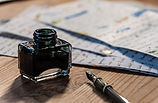
bottom of page
